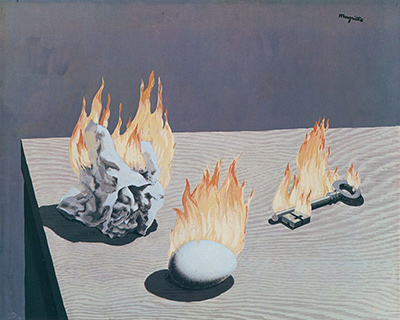René Magritte was a Belgian artist whose works fall under the genre of surrealism. He was quite popular during his lifetime and was known for portraying everyday ideas and objects in surprisingly different ways that got attention.
He was a big influence on pop art in the 20th century. Born in 1898 in Hainaut, Belgium, Magritte started drawing lessons in 1910, and began painting from the age of 15. The artist studied art at the Académie Royale des Beaux-Arts in Brussels with Constant Montald as this instructor.
Magritte worked with different painting techniques until 1926, when he created his first surrealist painting called, The Lost Jockey. Before this, he had dabbled with Impressionism, Cubism, and Futurism. His surrealist art, for which he is the most known, were heavily influenced by the French artist, André Breton, and the British artist, Edward James.
The Gradation of Fire is one of Magritte’s deeper pieces. This painting shows three objects on a wooden table: a piece of paper, an egg, and a key. All of them are burning. The grain pattern of the wood gives a strong effect to the depiction of the flames. In a previous painting, called The Ladder of Fire, he depicted a chair, a piece of paper, and a tuba burning. He also did several other paintings with the fire theme, and one of them was even called The Fire!
Magritte was inspired to paint The Gradation of Fire when he first learned how prehistoric humans first made fire by striking two stones together. This made him think of how it would feel like to be a prehistoric man, and the painting was the result. The depiction of fire in this painting appears absolute. The fire is not harming any of these items, just as it did not harm the stones which originally produced it. It is an interesting thought, and makes one wonder whether or not these other objects could give birth to something so magnificent.




